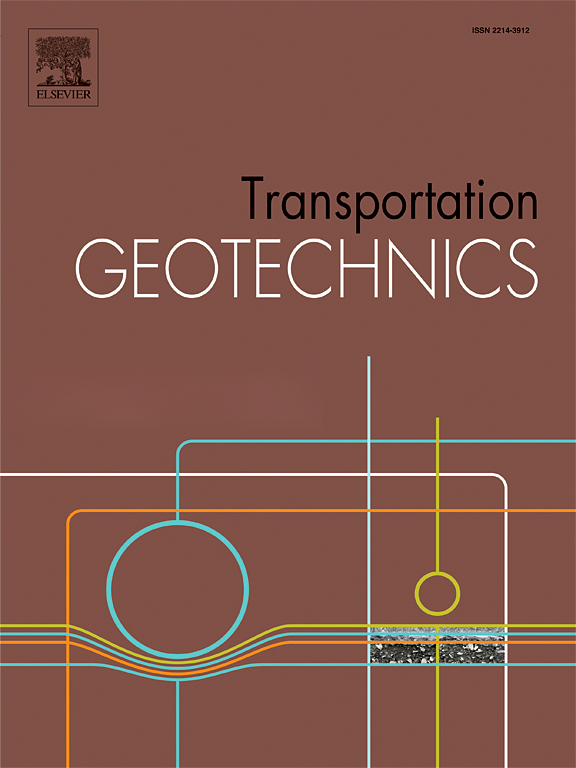Study on the impact of rock shape and volume fraction on the dynamic properties of soil-rock mixtures
IF 4.9
2区 工程技术
Q1 ENGINEERING, CIVIL
引用次数: 0
Abstract
The microstructure of a soil–rock matrix (SRM) is a determinant of its macroscopic physical and mechanical attributes. The influence of the shape and volume fraction (VF) of rock blocks on the dynamic properties of the SRM has not been subjected to quantitative analysis. Consequently, a suitable construction technique was developed for the fabrication of small-scale triaxial specimens incorporating artificial rocks of various shapes. A series of homogeneous SRM specimens with differing rock VFs and shapes were fabricated. These specimens were then exposed to a long-term dynamic load consisting of 15,000 cycles at a frequency of 1 Hz. The principal findings are summarized as follows: The construction method proposed is capable of producing small artificial rocks with dimensions of 3 mm or 5 mm in arbitrary shapes while maintaining consistency with the prototypes. The method holds significant promise for application in geotechnical testing. Under long-term dynamic loading, the rock VF effectively elevates the threshold cyclic stress ratio of the SRM, diminishes the Pore Water Pressure within the mixture, enhances the dynamic stiffness, and mitigates the cumulative strain. SRMs composed of rock shapes with increased angularity and reduced block sizes exhibit higher dynamic stiffness and cumulative strain. The threshold cyclic stress ratio for an SRM with a 40 % rock VF is approximately 0.04, and the pore pressure increment in the SRM exhibits a gradual change, which contrasts with the test outcomes for pure clay. The exponential-hyperbolic model provided a satisfactory fit for the pore pressure data, while the hyperbolic model yielded good fitting results for the cumulative strain of the SRM with a low rock VF. These findings contribute to an enhanced comprehension of the dynamic properties of railway subgrades filled with SRM under cyclic train loading conditions.
岩石形状和体积分数对土石混合体动力特性影响的研究
土石基质的微观结构是其宏观物理力学属性的决定因素。岩石块体的形状和体积分数(VF)对SRM动力特性的影响尚未得到定量分析。因此,开发了一种合适的施工技术,用于制作包含各种形状的人造岩石的小型三轴试件。制作了一系列具有不同岩石VFs和形状的均质SRM试样。然后,这些试件暴露于由15,000个周期组成的长期动荷载下,频率为1hz。主要研究结果如下:所提出的施工方法能够在与原型保持一致的情况下,制造出尺寸为3 mm或5 mm的任意形状的小人造岩石。该方法在岩土工程测试中具有重要的应用前景。在长期动加载作用下,岩石VF有效提高了SRM的阈值循环应力比,降低了混合体内部孔隙水压力,提高了动刚度,减轻了累积应变。由棱角增大、块体尺寸减小的岩石组成的srm具有较高的动刚度和累积应变。与纯粘土试验结果相比,含40% VF的SRM的阈值循环应力比约为0.04,孔隙压力增量呈逐渐变化趋势。指数-双曲模型对孔隙压力数据拟合较好,双曲模型对低VF条件下的SRM累积应变拟合较好。这些发现有助于加强对列车循环加载条件下SRM填充铁路路基动力特性的理解。
本文章由计算机程序翻译,如有差异,请以英文原文为准。
求助全文
约1分钟内获得全文
求助全文
来源期刊

Transportation Geotechnics
Social Sciences-Transportation
CiteScore
8.10
自引率
11.30%
发文量
194
审稿时长
51 days
期刊介绍:
Transportation Geotechnics is a journal dedicated to publishing high-quality, theoretical, and applied papers that cover all facets of geotechnics for transportation infrastructure such as roads, highways, railways, underground railways, airfields, and waterways. The journal places a special emphasis on case studies that present original work relevant to the sustainable construction of transportation infrastructure. The scope of topics it addresses includes the geotechnical properties of geomaterials for sustainable and rational design and construction, the behavior of compacted and stabilized geomaterials, the use of geosynthetics and reinforcement in constructed layers and interlayers, ground improvement and slope stability for transportation infrastructures, compaction technology and management, maintenance technology, the impact of climate, embankments for highways and high-speed trains, transition zones, dredging, underwater geotechnics for infrastructure purposes, and the modeling of multi-layered structures and supporting ground under dynamic and repeated loads.
 求助内容:
求助内容: 应助结果提醒方式:
应助结果提醒方式:


